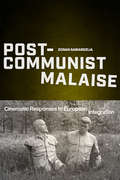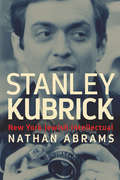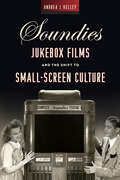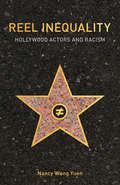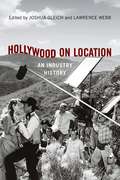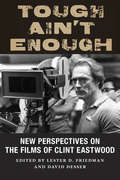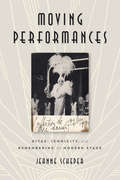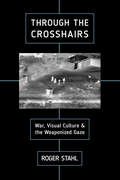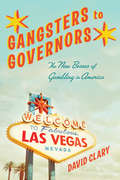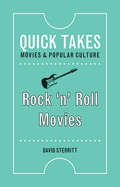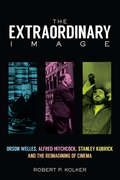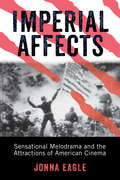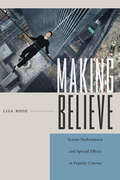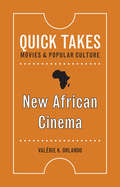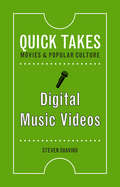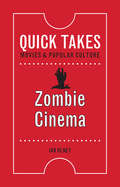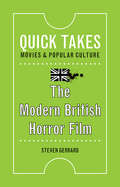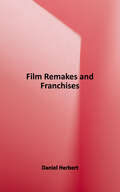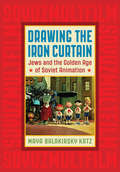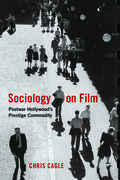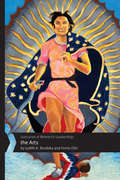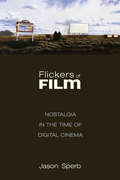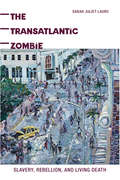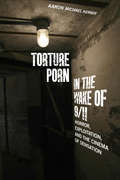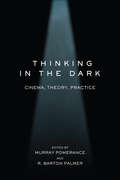- Table View
- List View
Post-Communist Malaise: Cinematic Responses to European Integration (Media Matters)
by Zoran SamardzijaThe collapse of communism in the Soviet Union and Eastern Europe was supposed to bring about the “end of history” with capitalism and liberal democracy achieving decisive victories. Europe would now integrate and reconcile with its past. However, the aftershocks of the financial crisis of 2008—the rise in right-wing populism, austerity politics, and mass migration—have shown that the ideological divisions which haunted Europe in the twentieth century still remain. It is within this context that Post-Communist Malaise revives discourses of political modernism and revisits debates from Marxism and seventies film theory. Analyzing work of Theo Angelopoulos, Vera Chytilová, Srdjan Dragojevic, Jean-Luc Godard, Miklós Jancsó, Emir Kusturica, Dušan Makavejev, Cristi Puiu, Jan Švankmajer, Andrei Tarkovsky, and Béla Tarr, the book focuses on how select cinemas from Eastern Europe and the Balkans critique the neoliberal integration of Europe whose failures fuel the rise of nationalism and right-wing politics. By politicizing art cinema from the regions, Post-Communist Malaise asks fundamental questions about film, aesthetics, and ideology. It argues for the utopian potential of the materiality of cinematic time to imagine a new political and cultural organization for Europe.
Stanley Kubrick: New York Jewish Intellectual
by Dr Nathan AbramsStanley Kubrick is generally acknowledged as one of the world’s great directors. Yet few critics or scholars have considered how he emerged from a unique and vibrant cultural milieu: the New York Jewish intelligentsia. Stanley Kubrick reexamines the director’s work in context of his ethnic and cultural origins. Focusing on several of Kubrick’s key themes—including masculinity, ethical responsibility, and the nature of evil—it demonstrates how his films were in conversation with contemporary New York Jewish intellectuals who grappled with the same concerns. At the same time, it explores Kubrick’s fraught relationship with his Jewish identity and his reluctance to be pegged as an ethnic director, manifest in his removal of Jewish references and characters from stories he adapted. As he digs deep into rare Kubrick archives to reveal insights about the director’s life and times, film scholar Nathan Abrams also provides a nuanced account of Kubrick’s cinematic artistry. Each chapter offers a detailed analysis of one of Kubrick’s major films, including Lolita, Dr. Strangelove, 2001, A Clockwork Orange, Barry Lyndon, The Shining, Full Metal Jacket, and Eyes Wide Shut. Stanley Kubrick thus presents an illuminating look at one of the twentieth century’s most renowned and yet misunderstood directors.
Soundies Jukebox Films and the Shift to Small-Screen Culture (Techniques of the Moving Image)
by Andrea J. KelleySoundies Jukebox Films and the Shift to Small-Screen Culture is the first and only book to position what are called “Soundies” within the broader cultural and technological milieu of the 1940s. From 1940 to 1946, these musical films circulated in everyday venues, including bars, bowling alleys, train stations, hospitals, and even military bases. Viewers would pay a dime to watch them playing on the small screens of the Panoram jukebox. This book expands U.S. film history beyond both Hollywood and institutional film practices. Examining the dynamics between Soundies’ short musical films, the Panoram’s film-jukebox technology, their screening spaces and their popular discourse, Andrea J. Kelley provides an integrative approach to historic media exhibition. She situates the material conditions of Soundies’ screening sites alongside formal considerations of the films and their unique politics of representation to illuminate a formative moment in the history of the small screen.
Reel Inequality: Hollywood Actors and Racism
by Nancy Wang YuenWhen the 2016 Oscar acting nominations all went to whites for the second consecutive year, #OscarsSoWhite became a trending topic. Yet these enduring racial biases afflict not only the Academy Awards, but also Hollywood as a whole. Why do actors of color, despite exhibiting talent and bankability, continue to lag behind white actors in presence and prominence? Reel Inequality examines the structural barriers minority actors face in Hollywood, while shedding light on how they survive in a racist industry. The book charts how white male gatekeepers dominate Hollywood, breeding a culture of ethnocentric storytelling and casting. Nancy Wang Yuen interviewed nearly a hundred working actors and drew on published interviews with celebrities, such as Viola Davis, Chris Rock, Gina Rodriguez, Oscar Isaac, Lucy Liu, and Ken Jeong, to explore how racial stereotypes categorize and constrain actors. Their stories reveal the day-to-day racism actors of color experience in talent agents’ offices, at auditions, and on sets. Yuen also exposes sexist hiring and programming practices, highlighting the structural inequalities that actors of color, particularly women, continue to face in Hollywood. This book not only conveys the harsh realities of racial inequality in Hollywood, but also provides vital insights from actors who have succeeded on their own terms, whether by sidestepping the system or subverting it from within. Considering how their struggles impact real-world attitudes about race and diversity, Reel Inequality follows actors of color as they suffer, strive, and thrive in Hollywood.
Hollywood on Location: An Industry History
by Jennifer Lynn Peterson Sheri Chinen Biesen Noelle Griffis Daniel Steinhart Julian StringerLocation shooting has always been a vital counterpart to soundstage production, and at times, the primary form of Hollywood filmmaking. But until now, the industrial and artistic development of this production practice has been scattered across the margins of larger American film histories. Hollywood on Location is the first comprehensive history of location shooting in the American film industry, showing how this mode of filmmaking changed Hollywood business practices, production strategies, and visual style from the silent era to the present. The contributors explore how location filmmaking supplemented and later, supplanted production on the studio lots. Drawing on archival research and in-depth case studies, the seven contributors show how location shooting expanded the geography of American film production, from city streets and rural landscapes to far-flung territories overseas, invoking a new set of creative, financial, technical, and logistical challenges. Whereas studio filmmaking sought to recreate nature, location shooting sought to master it, finding new production values and production economies that reshaped Hollywood’s modus operandi.
Tough Ain't Enough: New Perspectives on the Films of Clint Eastwood
by Professor Lester D. Friedman Professor David Desser Stephen Prince Jonathan Kirshner Diane Carson David Sterritt Murray Pomerance Lucy Bolton Alexandra Keller Charity LofthouseThroughout his lengthy career as both an actor and a director, Clint Eastwood has appeared in virtually every major film genre and, at this point in his career, has emerged as one of America’s most popular, recognizable, and respected filmmakers. He also remains a controversial figure in the political landscape, often characterized as the most prominent conservative voice in mostly liberal Hollywood. At Eastwood’s late age, his critical success as actor and director, his combative willingness to confront serious cultural issues in his films, and his undeniable talent behind the camera all call for a new and comprehensive study that considers and contextualizes his multiple roles, both on and off screen. Tough Ain’t Enough offers readers a series of original essays by prominent cinema scholars that explore the actor-director’s extensive career. The result is a far-reaching and nuanced portrait of one of America’s most prolific and thoughtful filmmakers.
Moving Performances: Divas, Iconicity, and Remembering the Modern Stage
by Jeanne ScheperFabulous yet fierce, imperious yet impetuous, boss yet bitchy—divas are figures of paradox. Their place in culture is equally contradictory, as they are simultaneously venerated and marginalized, hailed as timeless but then frequently forgotten or exhumed as cult icons by future generations. Focusing on four early twentieth-century divas—Aida Overton Walker, Loïe Fuller, Libby Holman, and Josephine Baker—who were icons in their own time, Moving Performances considers what their past and current reception reveals about changing ideas of race and gender. Jeanne Scheper examines how iconicity can actually work to the diva’s detriment, reducing her to a fetish object, a grotesque, or a figure of nostalgia. Yet she also locates more productive modes of reception that reach to revive the diva’s moving performances, imbuing her with an affective afterlife. As it offers innovative theorizations of performance, reception, and affect, Moving Performances also introduces readers to four remarkable women who worked as both cultural producers and critics, deftly subverting the tropes of exoticism, orientalism, and primitivism commonly used to dismiss women of color. Rejecting iconic depictions of these divas as frozen in a past moment, Scheper vividly demonstrates how their performances continue to inspire ongoing movements.
Through the Crosshairs: War, Visual Culture, and the Weaponized Gaze (War Culture)
by Roger StahlNow that it has become so commonplace, we rarely blink an eye at camera footage framed by the crosshairs of a sniper’s gun or from the perspective of a descending smart bomb. But how did this weaponized gaze become the norm for depicting war, and how has it influenced public perceptions? Through the Crosshairs traces the genealogy of this weapon’s-eye view across a wide range of genres, including news reports, military public relations images, action movies, video games, and social media posts. As he tracks how gun-camera footage has spilled from the battlefield onto the screens of everyday civilian life, Roger Stahl exposes how this raw video is carefully curated and edited to promote identification with military weaponry, rather than with the targeted victims. He reveals how the weaponized gaze is not only a powerful propagandistic frame, but also a prime site of struggle over the representation of state violence.
Gangsters to Governors: The New Bosses of Gambling in America
by David ClaryGenerations ago, gambling in America was an illicit activity, dominated by gangsters like Benny Binion and Bugsy Siegel. Today, forty-eight out of fifty states permit some form of legal gambling, and America’s governors sit at the head of the gaming table. But have states become addicted to the revenue gambling can bring? And does the potential of increased revenue lead them to place risky bets on new casinos, lotteries, and online games? In Gangsters to Governors, journalist David Clary investigates the pros and cons of the shift toward state-run gambling. Unearthing the sordid history of America’s gaming underground, he demonstrates the problems with prohibiting gambling while revealing how today’s governors, all competing for a piece of the action, promise their citizens payouts that are rarely delivered. Clary introduces us to a rogue’s gallery of colorful characters, from John “Old Smoke” Morrissey, the Irish-born gangster who built Saratoga into a gambling haven in the nineteenth century, to Sheldon Adelson, the billionaire casino magnate who has furiously lobbied against online betting. By exploring the controversial histories of legal and illegal gambling in America, he offers a fresh perspective on current controversies, including bans on sports and online betting. Entertaining and thought-provoking, Gangsters to Governors considers the past, present, and future of our gambling nation. Author's website (http://www.davidclaryauthor.com)
Rock 'n' Roll Movies (Quick Takes: Movies and Popular Culture)
by David SterrittRock ‘n’ Roll Movies presents an eclectic look at the many manifestations of rock in motion pictures, from teen-oriented B-movies to Hollywood blockbusters to avant-garde meditations to reverent biopics to animated shorts to performance documentaries. Acclaimed film critic David Sterritt considers the diverse ways that filmmakers have regarded rock ‘n’ roll, some cynically cashing in on its popularity and others responding to the music as sincere fans, some depicting rock as harmless fun and others representing it as an open challenge to mainstream norms.
The Extraordinary Image: Orson Welles, Alfred Hitchcock, Stanley Kubrick, and the Reimagining of Cinema
by Robert P. KolkerWelles. Hitchcock. Kubrick. These names appear on nearly every list of the all-time greatest filmmakers. But what makes these directors so great? Despite their very different themes and sensibilities, is there a common genius that unites them and elevates their work into the realm of the sublime? The Extraordinary Image takes readers on a fascinating journey through the lives and films of these three directors, identifying the qualities that made them cinematic visionaries. Reflecting on a lifetime of teaching and writing on these filmmakers, acclaimed film scholar Robert P. Kolker offers a deeply personal set of insights on three artists who have changed the way he understands movies. Spotlighting the many astonishing images and stories in films by Welles, Hitchcock, Kubrick, he also considers how they induce a state of amazement that transports and transforms the viewer. Kolker's accessible prose invites readers to share in his own continued fascination and delight at these directors' visual inventiveness, even as he lends his expertise to help us appreciate the key distinctions between the unique cinematic universes they each created. More than just a celebration of three cinematic geniuses, The Extraordinary Image is an exploration of how movies work, what they mean, and why they bring us so much pleasure.
Imperial Affects: Sensational Melodrama and the Attractions of American Cinema
by Jonna EagleImperial Affects is the first sustained account of American action-based cinema as melodrama. From the earliest war films through the Hollywood Western and the late-century action cinema, imperialist violence and mobility have been produced as sites of both visceral pleasure and moral virtue. Suffering and omnipotence operate as twinned affects in this context, inviting identification with an American national subject constituted as both victimized and invincible—a powerful and persistent conjunction traced here across a century of cinema.
Making Believe: Screen Performance and Special Effects in Popular Cinema
by Lisa BodeIn the past twenty years, we have seen the rise of digital effects cinema in which the human performer is entangled with animation, collaged with other performers, or inserted into perilous or fantastic situations and scenery. Making Believe sheds new light on these developments by historicizing screen performance within the context of visual and special effects cinema and technological change in Hollywood filmmaking, through the silent, early sound, and current digital eras. Making Believe incorporates North American film reviews and editorials, actor and crew interviews, trade and fan magazine commentary, actor training manuals, and film production publicity materials to discuss the shifts in screen acting practice and philosophy around transfiguring makeup, doubles, motion capture, and acting to absent places or characters. Along the way it considers how performers and visual and special effects crew work together, and struggle with the industry, critics, and each other to define the aesthetic value of their work, in an industrial system of technological reproduction. Bode opens our eyes to the performing illusions we love and the tensions we experience in wanting to believe in spite of our knowledge that it is all make believe in the end.
New African Cinema
by Valérie K. OrlandoNew African Cinema examines the pressing social, cultural, economic, and historical issues explored by African filmmakers from the early post-colonial years into the new millennium. Offering an overview of the development of postcolonial African cinema since the 1960s, Valérie K. Orlando highlights the variations in content and themes that reflect the socio-cultural and political environments of filmmakers and the cultures they depict in their films. Orlando illuminates the diverse themes evident in the works of filmmakers such as Ousmane Sembène’s Ceddo (Senegal, 1977), Sarah Maldoror’s Sambizanga (Angola, 1972), Assia Djebar’s La Nouba des femmes de Mont Chenoua (The Circle of women of Mount Chenoua, Algeria, 1978), Zézé Gamboa’s The Hero (Angola, 2004) and Abderrahmane Sissako’s Timbuktu (Mauritania, 2014), among others. Orlando also considers the influence of major African film schools and their traditions, as well as European and American influences on the marketing and distribution of African film. For those familiar with the polemics of African film, or new to them, Orlando offers a cogent analytical approach that is engaging.
Digital Music Videos
by Steven ShaviroMusic videos today sample and rework a century’s worth of movies and other pop culture artifacts to offer a plethora of visions and sounds that we have never encountered before. As these videos have proliferated online, they have become more widely accessible than ever before. In Digital Music Videos, Steven Shaviro examines the ways that music videos interact with and change older media like movies and gallery art; the use of technologies like compositing, motion control, morphing software, and other digital special effects in order to create a new organization of time and space; how artists use music videos to project their personas; and how less well known musicians use music videos to extend their range and attract attention. Surveying a wide range of music videos, Shaviro highlights some of their most striking innovations while illustrating how these videos are creating a whole new digital world for the music industry.
Zombie Cinema
by Ian OlneyIt’s official: the zombie apocalypse is here. The living dead have been lurking in popular culture since the 1930s, but they have never been as ubiquitous or as widely-embraced as they are today.Zombie Cinema is a lively and accessible introduction to this massively popular genre. Presenting a historical overview of zombie appearances in cinema and on television, Ian Olney also considers why, more than any other horror movie monster, zombies have captured the imagination of twenty-first-century audiences. Surveying the landmarks of zombie film and TV, from White Zombie to The Walking Dead, the book also offers unique insight into why zombies have gone global, spreading well beyond the borders of American and European cinema to turn up in films from countries as far-flung as Cuba, India, Japan, New Zealand, and Nigeria. Both fun and thought-provoking, Zombie Cinema will give readers a new perspective on our ravenous hunger for the living dead.
The Modern British Horror Film (Quick Takes: Movies and Popular Culture)
by Steven GerrardWhen you think of British horror films, you might picture the classic Hammer Horror movies, with Christopher Lee, Peter Cushing, and blood in lurid technicolor. Yet British horror has undergone an astonishing change and resurgence in the twenty-first century, with films that capture instead the anxieties of post-Millennial viewers. Tracking the revitalization of the British horror film industry over the past two decades, media expert Steven Gerrard also investigates why audiences have flocked to these movies. To answer that question, he focuses on three major trends: “hoodie horror” movies responding to fears about Britain’s urban youth culture; “great outdoors” films where Britain’s forests, caves, and coasts comprise a terrifying psychogeography; and psychological horror movies in which the monster already lurks within us. Offering in-depth analysis of numerous films, including The Descent, Outpost, and The Woman in Black, this book takes readers on a lively tour of the genre’s highlights, while provocatively exploring how these films reflect viewers’ gravest fears about the state of the nation. Whether you are a horror buff, an Anglophile, or an Anglophobe, The Modern British Horror Film is sure to be a thrilling read.
Film Remakes and Franchises (Quick Takes: Movies and Popular Culture)
by Daniel HerbertContemporary media seems incredibly unoriginal, as Hollywood produces an endless flood of remakes, sequels, reboots, and franchises. We watch as the same stories, characters, and images appear again and again in different films, on new platforms, and as toys and other merchandise. Are these works simply crass commercial products, utterly devoid of creativity, or do they offer filmmakers a unique opportunity to reimagine iconic characters and modern myths? <p><p>Film Remakes and Franchises examines how remakes and sequels have been central to the film industry from its very inception, yet also considers how the recent trends toward reboots and transmedia franchises depart from those historical precedents. Film scholar Daniel Herbert not only analyzes the film industry's increasing reliance on recycled product but also asks why audiences are currently so drawn to such movies. In addition, he explores how contemporary filmmakers have used reboots and franchise movies to inject timely social commentary and diversity into established media properties. <p><p>A lively and accessible overview that covers everything from You've Got Mail to The Force Awakens, Film Remakes and Franchises raises essential questions about the intersection of business and creativity in Hollywood today.
Drawing the Iron Curtain: Jews and the Golden Age of Soviet Animation
by Maya Balakirsky KatzIn the American imagination, the Soviet Union was a drab cultural wasteland, a place where playful creative work and individualism was heavily regulated and censored. Yet despite state control, some cultural industries flourished in the Soviet era, including animation. Drawing the Iron Curtain tells the story of the golden age of Soviet animation and the Jewish artists who enabled it to thrive. Art historian Maya Balakirsky Katz reveals how the state-run animation studio Soyuzmultfilm brought together Jewish creative personnel from every corner of the Soviet Union and served as an unlikely haven for dissidents who were banned from working in other industries. Surveying a wide range of Soviet animation produced between 1919 and 1989, from cutting-edge art films like Tale of Tales to cartoons featuring "Soviet Mickey Mouse" Cheburashka, she finds that these works played a key role in articulating a cosmopolitan sensibility and a multicultural vision for the Soviet Union. Furthermore, she considers how Jewish filmmakers used animation to depict distinctive elements of their heritage and ethnic identity, whether producing films about the Holocaust or using fellow Jews as models for character drawings. Providing a copiously illustrated introduction to many of Soyuzmultfilm's key artistic achievements, while revealing the tumultuous social and political conditions in which these films were produced, Drawing the Iron Curtain has something to offer animation fans and students of Cold War history alike.
Sociology on Film: Postwar Hollywood's Prestige Commodity
by Professor Chris CagleAfter World War II, Hollywood’s “social problem films”—tackling topical issues that included racism, crime, mental illness, and drug abuse—were hits with critics and general moviegoers alike. In an era of film famed for its reliance on pop psychology, these movies were a form of popular sociology, bringing the academic discipline’s concerns to a much broader audience. Sociology on Film examines how the postwar “problem film” translated contemporary policy debates and intellectual discussions into cinematic form in order to become one of the preeminent genres of prestige drama. Chris Cagle chronicles how these movies were often politically fractious, the work of progressive directors and screenwriters who drew scrutiny from the House Un-American Activities Committee. Yet he also proposes that the genre helped to construct an abstract discourse of “society” that served to unify a middlebrow American audience. As he considers the many forms of print media that served to inspire social problem films, including journalism, realist novels, and sociological texts, Cagle also explores their distinctive cinematic aesthetics. Through a close analysis of films like Gentleman’s Agreement, The Lost Weekend, and Intruder in the Dust, he presents a compelling case that the visual style of these films was intimately connected to their more expressly political and sociological aspirations. Sociology on Film demonstrates how the social problem picture both shaped and reflected the middle-class viewer’s national self-image, making a lasting impact on Hollywood’s aesthetic direction.
Junctures in Women's Leadership: The Arts (Junctures: Case Studies in Women's Leade #3)
by Judith K. Brodsky Ferris OlinIn this third volume of the series Junctures: Case Studies in Women’s Leadership, Judith K. Brodsky and Ferris Olin profile female leaders in music, theater, dance, and visual art. The diverse women included in Junctures in Women's Leadership: The Arts have made their mark by serving as executives or founders of art organizations, by working as activists to support the arts, or by challenging stereotypes about women in the arts. The contributors explore several important themes, such as the role of feminist leadership in changing cultural values regarding inclusivity and gender parity, as well as the feminization of the arts and the power of the arts as cultural institutions. Amongst the women discussed are Bertha Honoré Palmer, Louise Noun, Samella Lewis, Julia Miles, Miriam Colón, Jaune Quick-To-See Smith, Bernice Steinbaum, Anne d’Harnoncourt, Martha Wilson, Jawole Willa Jo Zollar, Kim Berman, Gilane Tawadros, Joanna Smith, and Veomanee Douangdala.
Flickers of Film
by Jason SperbWhether paying tribute to silent films in Hugo and The Artist or celebrating arcade games in Tron: Legacy and Wreck-It-Ralph, Hollywood suddenly seems to be experiencing a wave of intense nostalgia for outmoded technologies. To what extent is that a sincere lament for modes of artistic production that have nearly vanished in an all-digital era? And to what extent is it simply a cynical marketing ploy, built on the notion that nostalgia has always been one of Hollywood's top-selling products? In Flickers of Film, Jason Sperb offers nuanced and unexpected answers to these questions, examining the benefits of certain types of film nostalgia, while also critiquing how Hollywood's nostalgic representations of old technologies obscure important aspects of their histories. He interprets this affection for the prehistory and infancy of digital technologies in relation to an industry-wide anxiety about how the digital has grown to dominate Hollywood, pushing it into an uncertain creative and economic future. Yet he also suggests that Hollywood's nostalgia for old technologies ignores the professionals who once employed them, as well as the labor opportunities that have been lost through the computerization and outsourcing of film industry jobs. Though it deals with nostalgia, Flickers of Film is strikingly cutting-edge, one of the first studies to critically examine Pixar's role in the film industry, cinematic representations of videogames, and the economic effects of participatory culture. As he takes in everything from Terminator: Salvation to The Lego Movie, Sperb helps us see what's distinct about this recent wave of self-aware nostalgic films--how Hollywood nostalgia today isn't what it used to be.
The Transatlantic Zombie: Slavery, Rebellion, and Living Death
by Sarah J. LauroOur most modern monster and perhaps our most American, the zombie that is so prevalent in popular culture today has its roots in African soul capture mythologies. The Transatlantic Zombie provides a more complete history of the zombie than has ever been told, explaining how the myth's migration to the New World was facilitated by the transatlantic slave trade, and reveals the real-world import of storytelling, reminding us of the power of myths and mythmaking, and the high stakes of appropriation and homage. Beginning with an account of a probable ancestor of the zombie found in the Kongolese and Angolan regions of seventeenth-century Africa and ending with a description of the way, in contemporary culture, new media are used to facilitate zombie-themed events, Sarah Juliet Lauro plots the zombie's cultural significance through Caribbean literature, Haitian folklore, and American literature, film, and the visual arts. The zombie entered US consciousness through the American occupation of Haiti, the site of an eighteenth-century slave rebellion that became a war for independence, thus making the figuration of living death inseparable from its resonances with both slavery and rebellion. Lauro bridges African mythology and US mainstream culture by articulating the ethical complications of the zombie's invocation as a cultural conquest that was rebranded for the American cinema. As The Transatlantic Zombie shows, the zombie is not merely a bogeyman representing the ills of modern society, but a battleground over which a cultural war has been fought between the imperial urge to absorb exotic, threatening elements, and the originary, Afro-disaporic culture's preservation through a strategy of mythic combat.
Torture Porn in the Wake of 9/11
by Aaron Michael KernerSaw, Hostel, The Devil's Rejects: this wave of horror movies has been classed under the disparaging label "torture porn." Since David Edelstein coined the term for a New York magazine article a few years after 9/11, many critics have speculated that these movies simply reflect iconic images, anxieties, and sadistic fantasies that have emerged from the War on Terror. In this timely new study, Aaron Kerner challenges that interpretation, arguing that "torture porn" must be understood in a much broader context, as part of a phenomenon that spans multiple media genres and is rooted in a long tradition of American violence. Torture Porn in the Wake of 9/11 tackles a series of tough philosophical, historical, and aesthetic questions: What does it mean to call a film "sadistic," and how has this term been used to shut down critical debate? In what sense does torture porn respond to current events, and in what ways does it draw from much older tropes? How has torture porn been influenced by earlier horror film cycles, from slasher movies to J-horror? And in what ways has the torture porn aesthetic gone mainstream, popping up in everything from the television thriller Dexter to the reality show Hell's Kitchen? Reflecting a deep knowledge and appreciation for the genre, Torture Porn in the Wake of 9/11 is sure to resonate with horror fans. Yet Kerner's arguments should also strike a chord in anyone with an interest in the history of American violence and its current and future ramifications for the War on Terror.
Thinking in the Dark: Cinema, Theory, Practice
by Murray Pomerance R. Barton Palmer Colin Williamson Steven Rybin Steven Woodward Jeremy Blatter Professor William Rothman Tom Gunning Dudley Andrew Gilberto Perez Professor Kristen Hatch Dominic Lennard Alex Clayton Johannes Von Moltke Nathan Holmes Will Scheibel Jonah Corne Professor William Brown Daniel Morgan Professor Matthew Solomon Sarah Keller Tom ConleyToday's film scholars draw from a dizzying range of theoretical perspectives--they're just as likely to cite philosopher Gilles Deleuze as they are to quote classic film theorist André Bazin. To students first encountering them, these theoretical lenses for viewing film can seem exhilarating, but also overwhelming. Thinking in the Dark introduces readers to twenty-one key theorists whose work has made a great impact on film scholarship today, including Rudolf Arnheim, Sergei Eisenstein, Michel Foucault, Siegfried Kracauer, and Judith Butler. Rather than just discussing each theorist's ideas in the abstract, the book shows how those concepts might be applied when interpreting specific films by including an analysis of both a classic film and a contemporary one. It thus demonstrates how theory can help us better appreciate films from all eras and genres: from Hugo to Vertigo, from City Lights to Sunset Blvd., and from Young Mr. Lincoln to A.I. and Wall-E. The volume's contributors are all experts on their chosen theorist's work and, furthermore, are skilled at explaining that thinker's key ideas and terms to readers who are not yet familiar with them. Thinking in the Dark is not only a valuable resource for teachers and students of film, it's also a fun read, one that teaches us all how to view familiar films through new eyes. Theorists examined in this volume are: Rudolf Arnheim, Béla Balázs, Roland Barthes, André Bazin, Walter Benjamin, Judith Butler, Stanley Cavell, Michel Chion, Gilles Deleuze, Jean Douchet, Sergei Eisenstein, Jean Epstein, Michel Foucault, Siegfried Kracauer, Jacques Lacan, Vachel Lindsay, Christian Metz, Hugo Münsterberg, V. F. Perkins, Jacques Rancière, and Jean Rouch.
